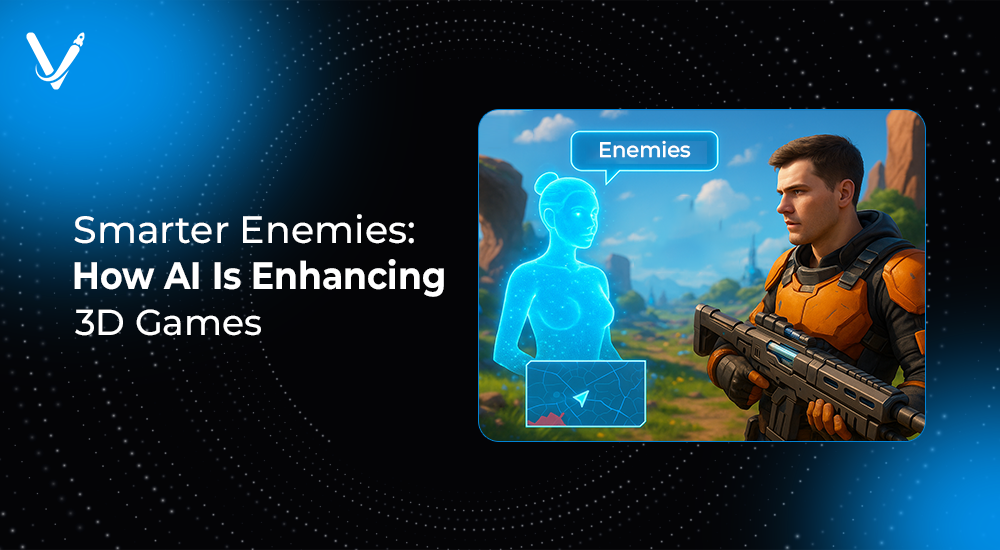Smarter Enemies: How AI Is Enhancing 3D Games


- Jun 20, 2025



When enemies in a game surprise you with clever flanking moves, adapt to your strategies, or coordinate attacks like real squads, it’s not just great design—it’s artificial intelligence in action. As 3D games grow in scale and complexity, traditional enemy logic no longer satisfies players looking for immersive, reactive worlds. AI is stepping in to change the rules of engagement, giving rise to smarter enemies that think, learn, and challenge.
A game development company designs, develops, and publishes video games using tools like Unity, Unreal Engine, and custom-built engines. These companies handle everything from game design, 3D modeling, and AI integration to multiplayer infrastructure and post-launch updates. At Vasundhara Infotech, we specialize in 3D game development powered by smart AI systems, creating immersive gameplay and intelligent enemy behavior.
This article explores how AI is revolutionizing enemy behavior in 3D gaming, diving deep into the mechanics, technologies, and design philosophies behind these advancements. From dynamic pathfinding to neural networks and procedural learning, we’ll uncover how smarter enemies are reshaping the player experience and pushing the boundaries of what’s possible in interactive entertainment.
Enemy AI has come a long way since the days of predictable attack patterns and fixed patrol routes. In early 3D games, enemies operated using finite-state machines or simple if-else logic. These systems were effective but easily exploitable.
As players became more experienced, developers recognized the need to craft more lifelike, adaptive, and unpredictable opponents. AI techniques have since evolved to include behavior trees, utility systems, machine learning, and goal-oriented action planning (GOAP). These methods allow enemies to react in real time, assess situations, and simulate intelligence.
Each generation of games has raised the bar for what’s expected in enemy intelligence, setting the stage for today’s AI-driven experiences.
Enemy intelligence isn’t just a technical flex—it’s critical to player immersion, engagement, and replayability. Smarter enemies create more satisfying challenges and make the game world feel alive.
Impact of intelligent enemy AI:
Without smart AI, even the most stunning 3D worlds can feel empty or repetitive. In contrast, well-executed AI creates emergent gameplay, where unscripted scenarios unfold based on player and enemy interactions.
Game developers leverage a combination of traditional and modern AI methods to build intelligent enemies that adapt and respond in real time.
Behavior trees are one of the most widely used structures in modern game AI. They allow for modular, reusable decision-making systems where enemies evaluate conditions and perform actions based on priority.
Use case:
In Assassin’s Creed, guards use behavior trees to patrol, investigate sounds, chase the player, or return to normal routines.
Benefits:
GOAP is a decision-making system where enemies plan a sequence of actions to achieve specific goals based on world states and priorities.
Example:
In F.E.A.R., AI enemies use GOAP to seek cover, flank the player, reload, and regroup dynamically.
Why it’s powerful:
AI enemies must move through 3D environments in believable ways. Pathfinding systems like A* (A-star) and NavMesh allow enemies to navigate terrain, avoid obstacles, and reposition intelligently.
Advanced additions:
Real-world example:
Halo’s Covenant enemies dynamically use terrain, vehicles, and elevation to outmaneuver players.
Machine learning introduces a new frontier in game AI where enemies can learn from players, adapt strategies over time, and improve without manual scripting.
Enemies trained with reinforcement learning can adapt by trial and error. They receive rewards or penalties based on actions and evolve optimal strategies.
Use case:
Ubisoft La Forge has experimented with reinforcement learning to develop AI agents that improve their tactics through thousands of simulations.
Neural networks allow AI to recognize patterns in gameplay, such as player movement or attack rhythms, and respond accordingly.
In action:
In experimental AI mods, enemies trained with neural nets have learned to dodge, counter, and mimic player behaviors effectively.
Procedural generation isn’t limited to terrain or levels—it also extends to enemy behavior. Procedural AI enables the generation of unique enemy patterns, personalities, and responses every time you play.
In practice:
Case Study: Shadow of Mordor’s Nemesis System
This system allowed orc enemies to remember past fights, grow in rank, and develop rivalries. Combined with procedural animation and AI, it created deeply personalized and dynamic enemies.
Why it works:
AI in 3D games isn’t just about tactics—it’s also about emotional expression and believability. Enemies that express fear, anger, confusion, or panic can create richer interactions and storytelling.
How emotional AI enhances gameplay:
Example:
In The Last of Us Part II, enemies call each other by name, mourn fallen allies, and change behavior based on emotional states.
This level of immersion elevates enemy AI beyond mechanics—it becomes a storytelling tool.
Developers have access to robust engines and middleware that simplify AI implementation.
Unity AI Toolkit
Unreal Engine
Third-party tools:
These tools make it easier to create believable AI without reinventing the wheel.
Creating advanced AI in games comes with its share of hurdles:
Performance Constraints
Real-time AI must be lightweight enough to run on multiple platforms, including consoles and VR devices.
Balancing Difficulty
Overly smart enemies can frustrate players. The challenge lies in making them believable, not unbeatable.
Debugging Complexity
AI decisions are harder to track and debug than scripted logic. Visualizers and logging systems become essential.
Ethical and Narrative Impact
Games with emotional AI must consider how enemy behavior affects narrative tone and player psychology. Is an enemy that pleads for mercy appropriate in all genres?
If you’re building smarter AI for 3D games, here are practical ways to start:
Define Player Expectations
Decide what kind of intelligence makes sense for your genre and audience. Tactical enemies in a stealth game differ from chaotic mobs in a hack-and-slash.
Start with Behavior Trees
They offer a scalable, modular way to implement decision-making that’s easy to iterate on.
Layer Complexity Gradually
Introduce randomness, memory, and learning in stages to avoid unpredictable or buggy behavior.
Use Analytics
Track player interaction with enemy AI to identify patterns, exploitations, and areas for improvement.
Balance with Playtesting
Test AI across skill levels and play styles to ensure fairness and challenge are well-balanced.
The future of AI in gaming points to even greater immersion and personalization.
Predictive AI
Systems that anticipate player actions and evolve enemy behavior mid-game.
AI-as-a-Service in Cloud Gaming
Enemy logic offloaded to cloud services, enabling deeper simulations without taxing local hardware.
Voice-Interactive AI Enemies
Enemies that respond to voice commands, taunts, or strategies spoken by the player.
Cross-game Memory
Imagine enemies that remember your actions across sequels or online worlds, creating persistent adversaries.
These innovations signal a future where enemy AI isn’t just a feature—it’s a character, a storyteller, and an adversary worth remembering.
AI is no longer just a backend mechanic in 3D games—it’s the beating heart of dynamic, engaging, and memorable encounters. From stealthy assassins to emotionally reactive bosses, smarter enemies deepen immersion and elevate player experience.
By embracing advanced AI techniques, developers can build worlds where every battle feels fresh, every encounter matters, and every enemy has a mind of its own.
At Vasundhara Infotech, we specialize in developing immersive 3D games powered by smart AI systems. If you’re ready to craft next-gen gameplay with intelligent enemies and adaptive design, partner with us and bring your vision to life.
Copyright © 2025 Vasundhara Infotech. All Rights Reserved.